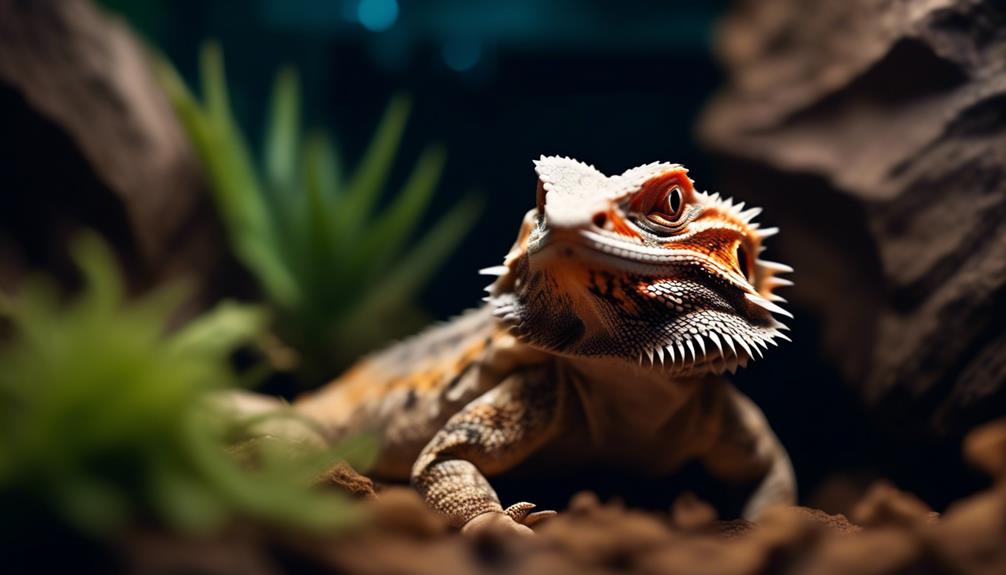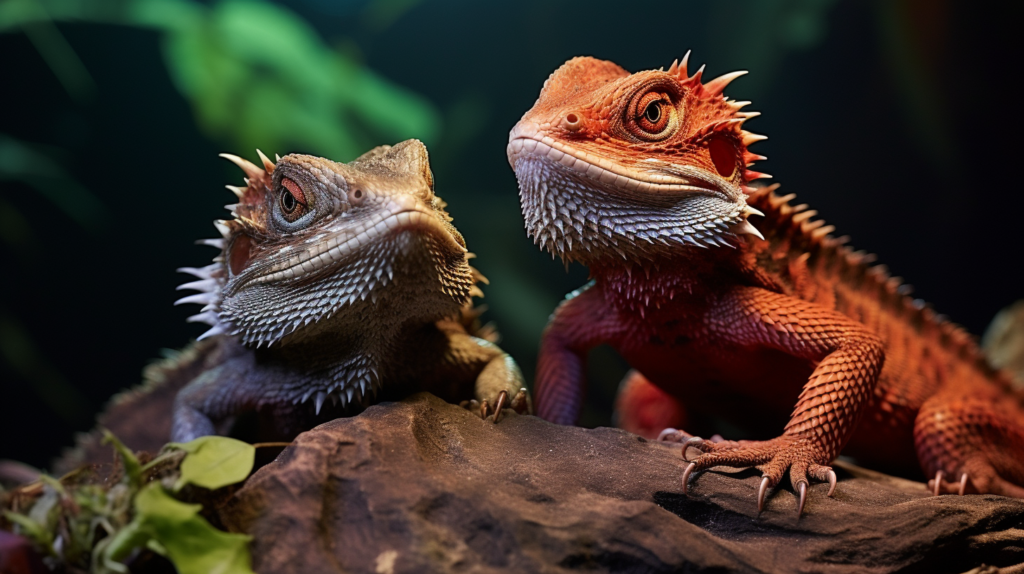So, you’ve noticed that your bearded dragon has been spending a lot of time hiding in its enclosure lately. You might be wondering why this behavior has suddenly started, and what it could mean for your pet.
There are several possible reasons for your bearded dragon’s hiding, and understanding them can help you ensure the well-being of your scaly companion.
Your bearded dragon might be hiding due to environmental stressors, health issues, or the shedding process. To address this, ensure their habitat is set up correctly, provide environmental enrichment, and monitor their health.
Environmental Stressors
If your bearded dragon is hiding, it may be due to environmental stressors such as improper temperature, lighting, or enclosure setup. Bearded dragons are sensitive to their environment, and any changes can cause them stress. One common environmental stressor is diet changes. If you’ve recently altered your dragon’s diet, it could be the reason for its hiding behavior. Bearded dragons are creatures of habit, and sudden changes in their food can lead to stress and hiding. It’s important to gradually introduce new foods to prevent this stress.
Another factor to consider is cage decorations. While you may have the best intentions when decorating your dragon’s enclosure, certain decorations can be stressful for them. For instance, if you’ve recently added new cage decorations that obstruct their usual basking spots or hiding areas, they may feel uneasy and choose to hide. It’s essential to ensure that the cage decorations provide ample space for basking, hiding, and climbing, as these activities are crucial for your dragon’s well-being.
If you’ve made recent changes to your dragon’s diet or cage decorations, try reverting to the previous setup to see if their behavior improves. By addressing these environmental stressors, you can create a more comfortable and familiar environment for your bearded dragon, ultimately reducing their hiding behavior and promoting their overall well-being.
Health Issues
Your bearded dragon may be hiding due to potential health issues, which require careful observation and prompt attention to ensure their well-being. Here are some common health issues that could be causing your bearded dragon to hide:
- Parasite infestation: Internal parasites such as pinworms or coccidia can cause your bearded dragon to feel weak and lethargic, leading them to seek out hiding spots. If left untreated, parasite infestations can have serious consequences for your pet’s health.
- Vitamin deficiencies: Bearded dragons require specific vitamins, such as vitamin D3 and calcium, to maintain their bone health and overall well-being. A deficiency in these essential nutrients can lead to conditions like metabolic bone disease, causing discomfort and prompting your bearded dragon to hide more often.
- Respiratory infections: Respiratory issues, such as pneumonia, can cause your bearded dragon to hide to conserve energy and reduce stress on their body. Wheezing, open-mouth breathing, or excessive mucus around the nose and mouth are signs of respiratory problems that require immediate veterinary attention.
- Digestive problems: If your bearded dragon is experiencing digestive issues, such as impaction or constipation, they may retreat to a hiding spot due to discomfort. Proper diet and hydration are crucial for preventing digestive issues in bearded dragons.
It’s essential to monitor your bearded dragon’s behavior closely and seek veterinary care if you suspect any health issues. Regular check-ups and a balanced diet can help prevent many of these health issues, ensuring a happy and active bearded dragon.
Shedding Process
After addressing potential health issues that could cause your bearded dragon to hide, it’s important to understand the shedding process they go through as part of their natural growth and renewal. Shedding, or molting, is a normal and essential part of a bearded dragon’s life. During shedding, your bearded dragon will shed its old skin to make way for new growth, allowing them to accommodate their increasing size. This process is often accompanied by noticeable changes in behavior, such as increased hiding and decreased appetite.
Diet changes can significantly impact the shedding process. Ensuring that your bearded dragon has a balanced diet rich in essential vitamins and minerals is crucial. A diet lacking in proper nutrition can lead to difficulties during shedding, potentially resulting in incomplete shedding or skin problems. Additionally, make sure your bearded dragon has access to a shallow bowl of water to help with hydration, which is important for a smooth shedding process.
Handling frequency should be reduced during the shedding period. Handling your bearded dragon too much while they’re shedding can cause stress and discomfort, potentially leading to complications with the shedding process. It’s best to allow your bearded dragon to shed undisturbed while maintaining a close eye on their health and behavior.
Understanding the shedding process and making necessary adjustments to their care during this time will help ensure a smooth and healthy shedding experience for your bearded dragon.
Territorial Behavior
During their territorial behavior, bearded dragons may exhibit signs of aggression and dominance to establish their space within their enclosure. This behavior is natural for them and is a way of asserting their dominance and maintaining their territory. Understanding this behavior can help you create a suitable environment for your bearded dragon.
Here are a few key points to consider regarding your bearded dragon’s territorial behavior:
- Social Interaction: Bearded dragons, like many other reptiles, have a need for social interaction, which can sometimes lead to territorial behaviors. They may display dominance when interacting with other dragons or even with their human caregivers.
- Aggressive Behavior: During territorial disputes, bearded dragons may show aggressive behavior, such as head bobbing, puffing up their beard, or even chasing or nipping at other dragons. It’s essential to understand that this behavior is a natural part of their social structure.
- Creating Suitable Enclosures: Providing multiple hiding spots, basking areas, and separate feeding and watering stations can help reduce territorial disputes among multiple bearded dragons in the same enclosure.
- Monitoring Behavior: Keeping an eye on your bearded dragon’s behavior can help you understand their social dynamics and intervene if necessary to prevent any aggressive encounters.
Understanding and respecting your bearded dragon’s territorial behavior can help you create a harmonious environment for them to thrive.
Temperature and Lighting Concerns
When setting up your bearded dragon’s enclosure, ensuring proper temperature and lighting is crucial for their health and well-being. Bearded dragons, like all reptiles, are ectothermic and rely on their environment to regulate their body temperature. Proper habitat setup is essential to mimic their natural environment and provide them with the warmth and light they need to thrive.
| Temperature | Lighting | Habitat Setup |
|---|---|---|
| 95-105°F | UVB and UVA rays | Basking spot with a heat lamp |
| 75-85°F | 12-14 hours of light | Hide spots for shade |
| 70-75°F | Full spectrum light | Thermometers for monitoring |
Your bearded dragon requires a basking spot with a temperature of 95-105°F to thermoregulate. This can be achieved by placing a heat lamp over a specific area in their enclosure. The UVB and UVA rays provided by full spectrum lighting are crucial for their overall health, including calcium absorption and synthesis of vitamin D3. Ensure your bearded dragon receives 12-14 hours of light per day to maintain their natural circadian rhythm.
In addition to the basking spot, it’s crucial to provide hide spots within the enclosure to allow your bearded dragon to find shade and regulate their body temperature as needed. Regularly monitor the temperature using thermometers placed at both the basking spot and the cooler side of the enclosure to ensure the optimal temperature gradient is maintained.
Frequently Asked Questions
Can Bearded Dragons Sense Emotions and Stress in Their Owners?
Yes, bearded dragons can sense emotions and stress in their owners. Your influence can impact their emotions. Stress signals from you may affect their behavior. It’s important to create a calm and positive environment for your beardie.
Do Bearded Dragons Enjoy Being Handled and Interacted With?
Handling your bearded dragon provides bonding opportunities and promotes social interaction. While it can be beneficial, it’s important to recognize their cues and comfort levels. Respect their boundaries and make handling a positive experience for them.
What Are Some Common Misconceptions About Bearded Dragon Care?
Feeding misconceptions and improper habitat setup can affect your bearded dragon’s behavior. Proper handling and socialization techniques are crucial for their well-being. Educating yourself on these aspects will help provide a happy, healthy environment for your pet.
How Can I Enrich My Bearded Dragon’s Environment to Prevent Hiding Behavior?
To prevent hiding behavior in your bearded dragon, enrich their environment with activities like basking spots, climbing branches, and hiding places. Set up the enclosure with varied textures, plants, and interactive toys to keep them engaged and stimulated.
Are There Any Specific Breeds of Bearded Dragons That Are More Prone to Hiding?
Some breeds of bearded dragons may exhibit more hiding behavior than others. It’s essential to provide environmental enrichment to create a comfortable and secure habitat for your pet, helping to minimize any tendencies towards concealment.
Conclusion
So, if your bearded dragon is hiding, don’t panic. It could be due to environmental stressors, health issues, shedding process, territorial behavior, or temperature and lighting concerns.
By understanding these factors, you can provide the necessary care and support for your pet. Remember to create a comfortable and secure environment, monitor their health, and ensure proper temperature and lighting.
With proper care, your bearded dragon will feel safe and secure in their home.


